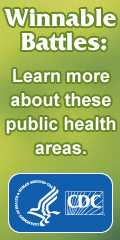Healthcare-Associated Infections
Did You Know? is a weekly feature from the Office for State, Tribal, Local and Territorial Support to inform your prevention activities. We invite you to read, share, and take action!
View the Current Did You Know?
January 27, 2017
- CDC’s newly released Winnable Battles final report shows meaningful improvements in key public health areas.
- Since 2009, rates of teen births and youth and adult smoking have declined significantly, and between 2008 and 2014, central line-associated bloodstream infections in acute care hospitals decreased by 50%.
- A color-coded dashboard shows where more work is needed, especially in obesity, foodborne illness, and motor vehicle injuries.
March 4, 2016
- People who receive medical care can get serious infections called healthcare-associated infections (HAIs), which can lead to sepsis or death.
- In certain kinds of hospitals, 1 in 4 HAIs are caused by antibiotic-resistant bacteria that are urgent and serious threats to health.
- Healthcare professionals should adopt critical actions with every patient every time to prevent HAIs and stop the spread of antibiotic resistance.
June 19, 2015
- Every year, more than 2 million Americans get sick [PDF-5.2MB] from bacteria that resist being killed by antibiotics.
- More than 150 organizations and companies met at the White House recently and made commitments [PDF-177KB] to improve antibiotic use.
- CDC’s proposed FY16 Antibiotic Resistance Solutions Initiative includes funding for states to prevent antibiotic resistance.
March 7, 2014
- Doctors in some hospitals prescribed up to 3 times as many antibiotics as doctors in similar areas of other hospitals, according to a newly released study of antibiotic prescribing practices in a sample of US hospitals, based on 2010 data.
- Reducing the use of high-risk antibiotics by 30% can lower C. difficile infections by 26%.
- State health departments can help hospitals develop antibiotic stewardship programs by facilitating the use of the CDC self-assessment checklist and an in-depth implementation tool.
November 22, 2013
- CDC’s Winnable Battles Progress Report, 2010–2015 [PDF-785KB] describes the progress being made in addressing these critical public health challenges.
- CDC and partners are on track to decrease teen birth rates by 20% [PDF-420KB], reduce motor vehicle crash fatalities by 31% [PDF-453KB], and reduce certain healthcare-associated infections in hospitals by 60% [PDF-178KB] by the 2015 target date.
- Identifying and focusing on Winnable Battles has helped promote progress. CDC will continue to work closely with partners at the national, state, and local levels to achieve Winnable Battle targets.
March 8, 2013
- Untreatable and hard-to-treat infections from carbapenem-resistant Enterobacteriaceae (CRE) germs are on the rise among patients in medical facilities, with 42 states reporting having had at least one patient test positive for one type of CRE.
- The increase in CRE infections is alarming because these bacteria kill up to half of people who get severe infections from them. CRE germs have become resistant to all or nearly all the antibiotics we have today.
- By following CDC guidelines, healthcare leaders and providers can halt CRE infections before they become widespread in medical facilities and potentially spread to otherwise healthy people outside of medical facilities.
July 27, 2012
- Today the HIV epidemic is far less visible, even though 1.1 million Americans live with HIV and approximately 50,000 more become infected each year.
- Fear, discrimination, and complacency continue to hamper progress against HIV, even though most Americans understand how the disease is transmitted.
- By promoting the Let’s Stop HIV Together campaign, you can help the public get the facts, get tested, and get involved [PDF - 1.1MB].
March 9, 2012
- Clostridium difficile, a bacterium, is linked to at least 14,000 U.S. deaths each year.
- 94% of these infections are connected to getting inpatient or outpatient medical care.
- Health care providers can stop C. difficile by following these 6 steps to prevention.
March 11, 2011
- Diabetes is the leading cause of kidney failure; it accounted for 44% of all new cases in 2008.
- The Diabetes Risk Test is available for your website to highlight American Diabetes Alert Day (March 22).
- The Guide to Community Preventive Services recommends a disease management approach to treat people with diabetes.
February 25, 2011
- 1 in 20 patients will get an infection during medical care in hospitals.
- CDC is working toward the elimination of healthcare-associated infections.
- You can play an important role in your state to reduce HAIs. CDC has guidelines to help implement the HHS Action Plan for HAI prevention and NHSN to track prevention progress.
Did You Know? information and web links are current as of their publication date. They may become outdated over time.
- Page last reviewed: October 11, 2016
- Page last updated: January 27, 2017
- Content source:



 ShareCompartir
ShareCompartir



